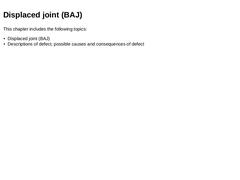
|
|
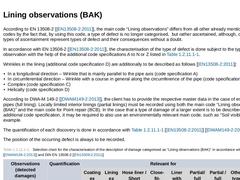
|
According to EN 13508-2 [ [EN13508-2:2011]], the main code “Lining observations” differs from all other already mentioned main codes by the fact that, by using this code, a type of defect is no longer categorised, but rather ascertained, although, de facto, many types of ascertainment represent types of defect and their consequences without a doubt. In accordance with EN 13508-2 [ [EN13508-2:2011]], the characterisation of the type of defect is done … |
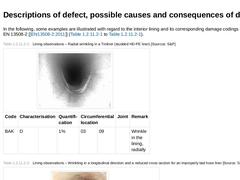
|
In the following, some examples are illustrated with regard to the interior lining and its corresponding damage codings according to EN 13508-2 [ [EN13508-2:2011]] (Image 2‑90 to Image 2‑92). (Table: Lining observations – Radial wrinkling in a Troliner (studded HD-PE liner)) (Table: Lining observations – Wrinkling in a longitudinal direction and a reduced cross section for an improperly laid hose liner) (Table: Lining observations – Buckling in the … |
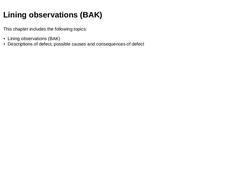
|
|
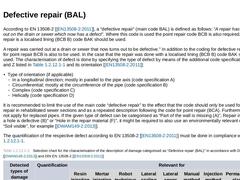
|
According to EN 13508-2 [ [EN13508-2:2011]], a “defective repair” (main code BAL) is defined as follows: “A repair has been carried out on the drain or sewer which now has a defect”. Where this code is used the point repair code BCB is also required. Where the repair is a localised lining (BCB B) code BAK should be used. A repair was carried out at a drain or sewer that now turns out to be defective.” In addition to the coding for defective repair, … |
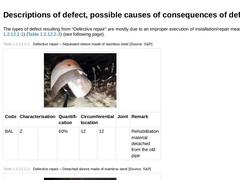
|
The types of defect resulting from “Defective repair” are mostly due to an improper execution of installation/repair measures (Image 2‑93) (Image 2‑94) (see following page). (Table: Defective repair – Separated sleeve made of stainless steel) (Table: Defective repair – Detached sleeve made of stainless steel) Possible causes of defect Among the following possible causes of types of damage categorised under the main code of “Defective repair” there exist, … |
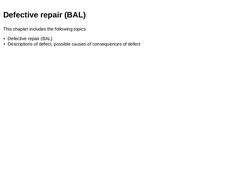
|
|
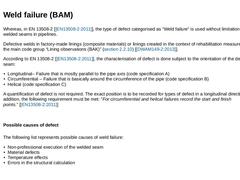
|
Whereas, in EN 13508-2 [ [EN13508-2:2011]], the type of defect categorised as “Weld failure” is used without limitations for all welded seams in pipelines. Defective welds in factory-made linings (composite materials) or linings created in the context of rehabilitation measures form part of the main code group “Lining observations (BAK)” ( (Lining observations (BAK))) [ [DWAM149-2:2013]]. According to EN 13508-2 [ [EN13508-2:2011]], the characterisation … |
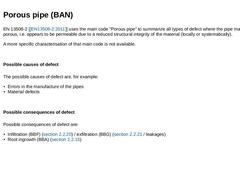
|
EN 13508-2 [ [EN13508-2:2011]] uses the main code “Porous pipe” to summarize all types of defect where the pipe material is porous, i.e. appears to be permeable due to a reduced structural integrity of the material (locally or systematically). A more specific characterisation of that main code is not available. Possible causes of defect The possible causes of defect are, for example: -
Errors in the manufacture of the pipes
-
Material defects
Possible … |
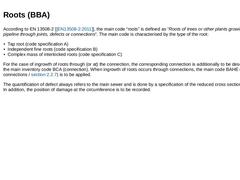
|
According to EN 13508-2 [ [EN13508-2:2011]], the main code “roots” is defined as “Roots of trees or other plants growing into the pipeline through joints, defects or connections“. The main code is characterised by the type of the root: -
Tap root (code specification A)
-
Independent fine roots (code specification B)
-
Complex mass of interlocked roots (code specification C)
For the case of ingrowth of roots through (or at) the connection, the corresponding … |
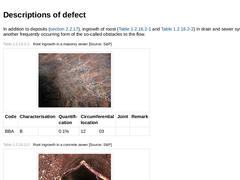
|
In addition to deposits ( (Settled deposits (BBC))), ingrowth of roost (Image 2‑100 and Image 2‑101) in drain and sewer systems is another frequently occurring form of the so-called obstacles to the flow. (Table: Root ingrowth in a masonry sewer) (Table: Root ingrowth in a concrete sewer) (Table: Root ingrowth in a concrete sewer) As the part of plants below the ground, roots have three functions: they guarantee the plant’s supply with water and nutrients … |
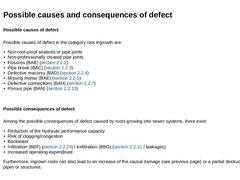
|
Possible causes of defect Possible causes of defect in the category root ingrowth are: -
Non-root-proof sealants or pipe joints
-
Non-professionally created pipe joints
-
Fissures (BAB) ( (Fissure / Crack (BAB)))
-
Pipe break (BAC) ( (Break / Collapse (BAC)))
-
Defective masonry (BAD) ( (Defective brickwork or masonry (BAD)))
-
Missing mortar (BAE) ( (Missing mortar (BAE)))
-
Defective connections (BAH) ( (Intruding connection (BAG) / Defective connection (…
|
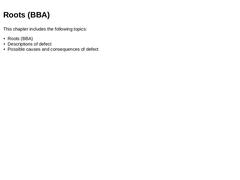
|
|
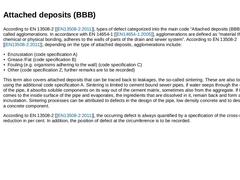
|
According to EN 13508-2 [ [EN13508-2:2011]], types of defect categorized into the main code “Attached deposits (BBB)” are also called agglomerations. In accordance with EN 14654-1 [ [EN14654-1:2005]], agglomerations are defined as “material that, due to chemical or physical bonding, adheres to the walls of parts of the drain and sewer system”. According to EN 13508-2 [ [EN13508-2:2011]], depending on the type of attached deposits, agglomerations … |
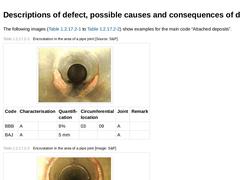
|
The following images (Image 2‑105 to Image 2‑108) show examples for the main code “Attached deposits”. (Table: Encrustation in the area of a pipe joint) (Table: Encrustation in the area of a pipe joint) (Table: Encrustation in the area of a connection) (Table: Grease deposits at the pipe wall) Possible causes of defect The causes of defect for attached deposits are different depending on the type of attachment. According to an encyclopaedia [ [Berte1991]], |
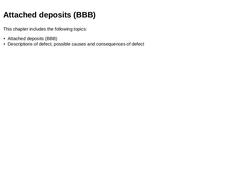
|
|
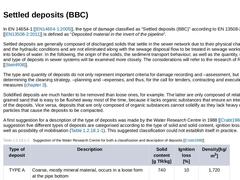
|
In EN 14654-1 [ [EN14654-1:2005]], the type of damage classified as “Settled deposits (BBC)” according to EN 13508-2 [ [EN13508-2:2011]] is defined as “Deposited material in the invert of the pipeline”. Settled deposits are generally composed of discharged solids that settle in the sewer network due to their physical characteristics and the hydraulic conditions and are not eliminated along with the sewage disposal flow to be treated in sewage works … |
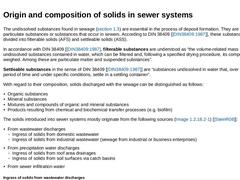
|
The undissolved substances found in sewage ( (Origin and characterisation of sewage)) are essential in the process of deposit formation. They are called solids, particulate substances or substances that occur in sewers. According to DIN 38409 [ [DIN38409:1987]], these substances are sub-divided into filterable solids (AFS) and settleable solids (ASS). In accordance with DIN 38409 [ [DIN38409:1987], filterable substances are understood as “the volume-… |
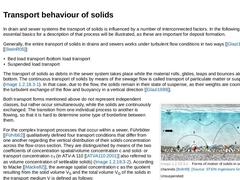
|
In drain and sewer systems the transport of solids is influenced by a number of interconnected factors. In the following, the most essential basics for a description of that process will be illustrated, as these are important for deposit formation. Generally, the entire transport of solids in drains and sewers works under turbulent flow conditions in two ways [ [Glazi1989]] [ [SteinR05]]: -
Bed load transport /bottom load transport
-
Suspended load transport
|
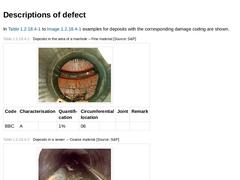
|
In Image 2‑114 to Image 2‑119 examples for deposits with the corresponding damage coding are shown. (Table: Deposits in the area of a manhole – Fine material) (Table: Deposits in a sewer – Coarse material) (Table: Deposits in a sewer – Coarse material) (Table: Deposits in a sewer – Hard or compacted material) (Table: Solidified deposits – Sewer filled with injection grouting mortar of a wrongly placed building pit anchorage) (Image: Hardened deposits - … |
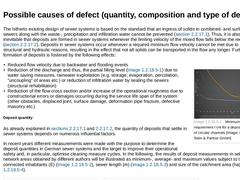
|
The hitherto existing design of sewer systems is based on the standard that an ingress of solids in combined- and surface water sewers along with the waste-, precipitation and infiltration water cannot be prevented ( (Origin and composition of solids in sewer systems)). Thus, it is also often inevitable that deposits are formed in sewer systems whenever the limiting velocity of the mixed flow falls below the required value ( (Transport behaviour … |
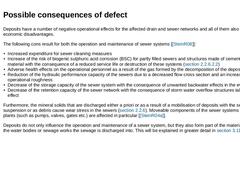
|
Deposits have a number of negative operational effects for the affected drain and sewer networks and all of them also involve economic disadvantages. The following cons result for both the operation and maintenance of sewer systems [ [SteinR08]]: -
Increased expenditure for sewer cleaning measures
-
Increase of the risk of biogenic sulphuric acid corrosion (BSC) for partly filled sewers and structures made of cement-bound material with the consequence …
|
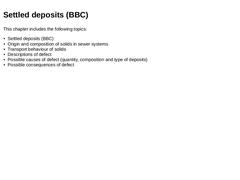
|
|
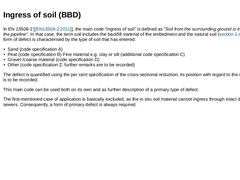
|
In EN 13508-2 [ [EN13508-2:2011]], the main code “Ingress of soil” is defined as “Soil from the surrounding ground is intruding into the pipeline”. In that case, the term soil includes the backfill material of the embedment and the natural soil ( (Embedment)). This form of defect is characterised by the type of soil that has entered: -
Sand (code specification A)
-
Peat (code specification B) Fine material e.g. clay or silt (additional code specification …
|
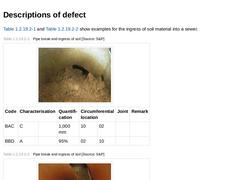
|
Image 2‑124 and Image 2‑125 show examples for the ingress of soil material into a sewer. (Table: Pipe break and ingress of soil) (Table: Pipe break and ingress of soil) |